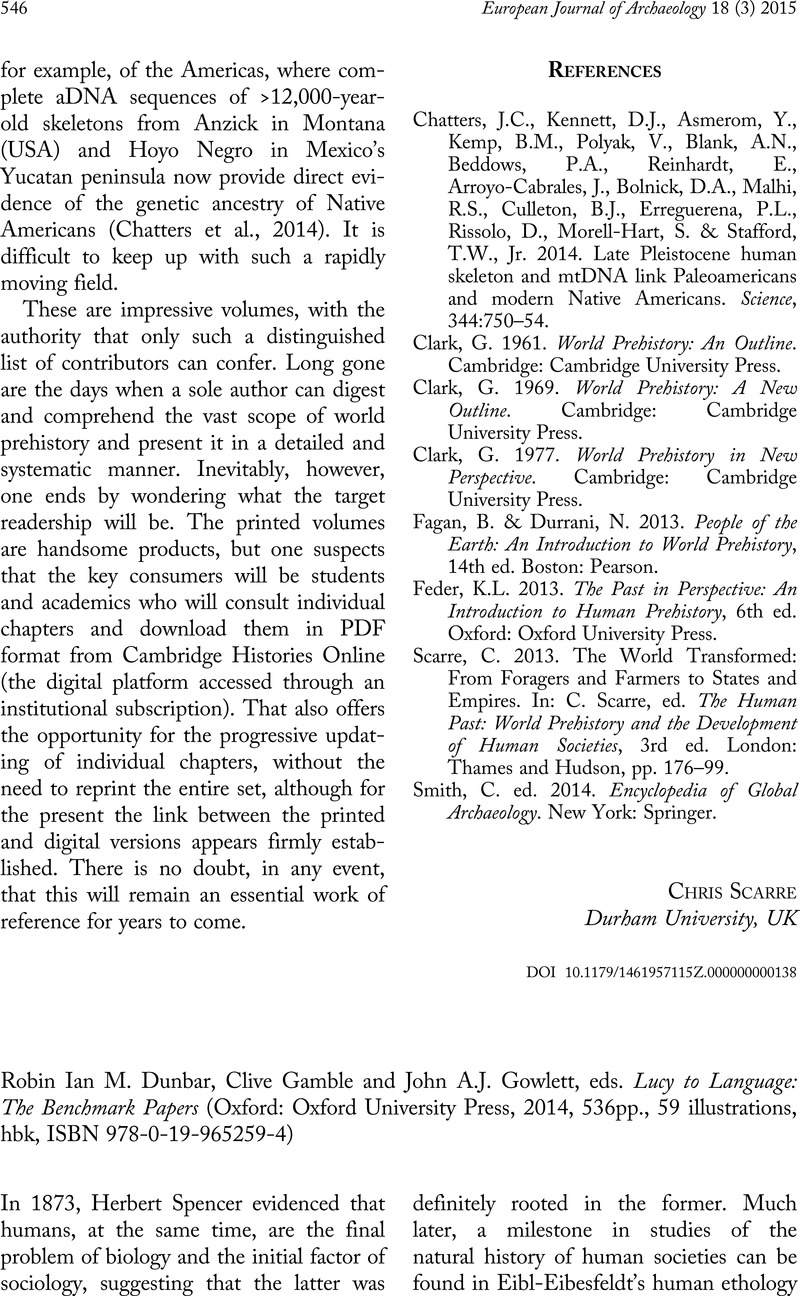No CrossRef data available.
Article contents
Tom Moore and Xoseé-Lois Armada, eds. Atlantic Europe in the First Millennium BC. Crossing the Divide (Oxford: Oxford University Press, 2011 690pp., 141 illustrations, hbk, ISBN 978-0-19-956795-9)
Published online by Cambridge University Press: 25 January 2017
Abstract
An abstract is not available for this content so a preview has been provided. Please use the Get access link above for information on how to access this content.

- Type
- Book Reviews
- Information
- Copyright
- Copyright © 2015 the European Association of Archaeologists
References
Bruner, E., de la Cuétara, J.M., Masters, M., Amano, H. & Ogihara, N.
2014. Functional Craniology and Brain Evolution: From Paleontology to Biomedicine. Frontiers in Neuroanatomy, 8: 19.Google Scholar
Bruner, E. & Iriki, A.
2015. Extending Mind, Visuospatial Integration, and the Evolution of the Parietal Lobes in the Human Genus. Quaternary International, [online] DOI:10.1016/j.quaint.2015.05.019, [accessed 2 June 2015]. Available at: http://www.sciencedirect.com/science/article/pii/S1040618215005054.Google Scholar
Bruner, E., Manzi, G. & Arsuaga, J.L.
2003. Encephalization and Allometric Trajectories in the Genus Homo: Evidence from the Neandertal and Modern Lineages. Proceedings of the National Academy of Sciences USA, 100: 15335–40.Google Scholar
Coolidge, F. & Wynn, T.
2005. Working Memory, its Executive Functions, and the Emergence of Modern Thinking. Cambridge Archaeological Journal, 15: 5–26.Google Scholar
Coward, F. & Gamble, C.
2008. Big Brains, Small Worlds: Material Culture and the Evolution of the Mind. Philosophical Transactions of the Royal Society, London, 363B: 1969–79.Google Scholar
Dunbar, R.I.M.
1992. Neocortex Size as a Constraint on Group Size in Primates. Journal of Human Evolution, 20: 469–93.Google Scholar
Dunbar, R.I.M.
1998. The Social Brain Hypothesis. Evolutionary Anthropology, 6: 178–90.Google Scholar
Gunz, P., Neubauer, S., Maureille, B. & Hublin, J.J.
2010. Brain Development after Birth Differs between Neanderthals and Modern Humans. Current Biology, 20: R921–22.Google Scholar
Iriki, A. & Taoka, M.
2012. Triadic (Ecological, Neural, Cognitive) Niche Construction: A Scenario of Human Brain Evolution Extrapolating Tool Use and Language from the Control of Reaching Actions. Philosophical Transactions of the Royal Society of London B Biological Sciences, 367: 10–23.Google Scholar
Machin, A.J. & Dunbar, R.I.M.
2011. The Brain Opiod Theory of Social Attachment: A Review of the Evidence. Behaviour, 148: 985–1025.Google Scholar
Malafouris, L.
2010. The Brain-Artefact Interface (BAI): A Challenge for Archaeology and Cultural Neuroscience. Social Cognitive & Affective Neuroscience, 5: 264–73.Google Scholar
Pearce, E., Stringer, C. & Dunbar, R.I.M.
2013. New Insights into Differences in Brain Organization between Neanderthals and Anatomically Modern Humans. Proceedings of the Royal Society, B 280: 20130168. doi: 10.1098/rspb.2013.0168.Google Scholar




